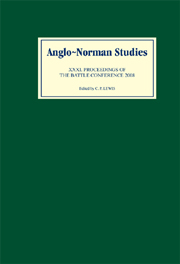Book contents
- Frontmatter
- Contents
- LIST OF ILLUSTRATIONS, MAPS, AND TABLES
- EDITOR'S PREFACE
- ABBREVIATIONS
- Kingship, Lordship, and Community in Eleventh-Century England (R. Allen Brown Memorial Lecture)
- Citadels of God: Monasteries, Violence, and the Struggle for Power in Northern England, 1135–1154
- Writing Civil War in Henry of Huntingdon's Historia Anglorum
- Land, Family, and Depredation: The Case of St Benet of Holme's Manor of Little Melton
- Brothers at Court: Urse de Abetot and Robert Dispenser
- Gerald of Wales and the Prophet Merlin
- The First Hundred Years of the Abbey of Tiron: Institutionalizing the Reform of the Forest Hermits
- All Roads Lead to Chartres: The House of Blois, the Papacy, and the Anglo-Norman Succession of 1135
- The Vita Ædwardi: The Politics of Poetry at Wilton Abbey
- William of Malmesbury, King Henry I, and the Gesta Regum Anglorum
- Twelfth-Century Receptions of a Text: Anglo-Norman Historians and Hegesippus
- LIST OF CONTENTS OF VOLUMES 1–30
The First Hundred Years of the Abbey of Tiron: Institutionalizing the Reform of the Forest Hermits
Published online by Cambridge University Press: 12 September 2012
- Frontmatter
- Contents
- LIST OF ILLUSTRATIONS, MAPS, AND TABLES
- EDITOR'S PREFACE
- ABBREVIATIONS
- Kingship, Lordship, and Community in Eleventh-Century England (R. Allen Brown Memorial Lecture)
- Citadels of God: Monasteries, Violence, and the Struggle for Power in Northern England, 1135–1154
- Writing Civil War in Henry of Huntingdon's Historia Anglorum
- Land, Family, and Depredation: The Case of St Benet of Holme's Manor of Little Melton
- Brothers at Court: Urse de Abetot and Robert Dispenser
- Gerald of Wales and the Prophet Merlin
- The First Hundred Years of the Abbey of Tiron: Institutionalizing the Reform of the Forest Hermits
- All Roads Lead to Chartres: The House of Blois, the Papacy, and the Anglo-Norman Succession of 1135
- The Vita Ædwardi: The Politics of Poetry at Wilton Abbey
- William of Malmesbury, King Henry I, and the Gesta Regum Anglorum
- Twelfth-Century Receptions of a Text: Anglo-Norman Historians and Hegesippus
- LIST OF CONTENTS OF VOLUMES 1–30
Summary
In a memorable section in his Monastic Order in England Dom David Knowles describes the ‘ferment of new life’ that was emerging in the western Church of the eleventh and twelfth centuries and reinvigorating the monastic tradition. The ‘new monasticism’ took as its inspiration the poverty of the early Church. Dissatisfied with monastic observance as it was practised in the years after 1000, inspirational leaders abandoned the structured life of their communities, which was often encumbered by the administration of endowments and obligations to lordly patrons, in search of a more contemplative approach. In western France those leaders took to the forest, seeking a wilderness where they could live the apostolic life. Eventually three monastic orders developed from these communities: the Fontevraudines; the Savignacs of Normandy; and the Tironensians, whose mother house lay in the wooded county of the Perche to the west of Chartres.
While the Fontevraudine and Savignac affiliations have been much discussed, Tiron has failed to attract historians. There is no major history of the order and the accounts of the foundation that have been given in general works rely heavily on the Life of the founder, Bernard, attributed to Geoffrey Grossus, a monk of Tiron. This work has been very influential, whose memorable images include the hermits' life flowering like a second Egypt. Yet there are other contemporary sources for the early history of Tiron, including an account in Orderic's Ecclesiastical History and a cartulary, and these sources present an opportunity to look at a charismatic foundation in succeeding generations.
- Type
- Chapter
- Information
- Anglo-Norman Studies 31Proceedings of the Battle Conference 2008, pp. 104 - 117Publisher: Boydell & BrewerPrint publication year: 2009



